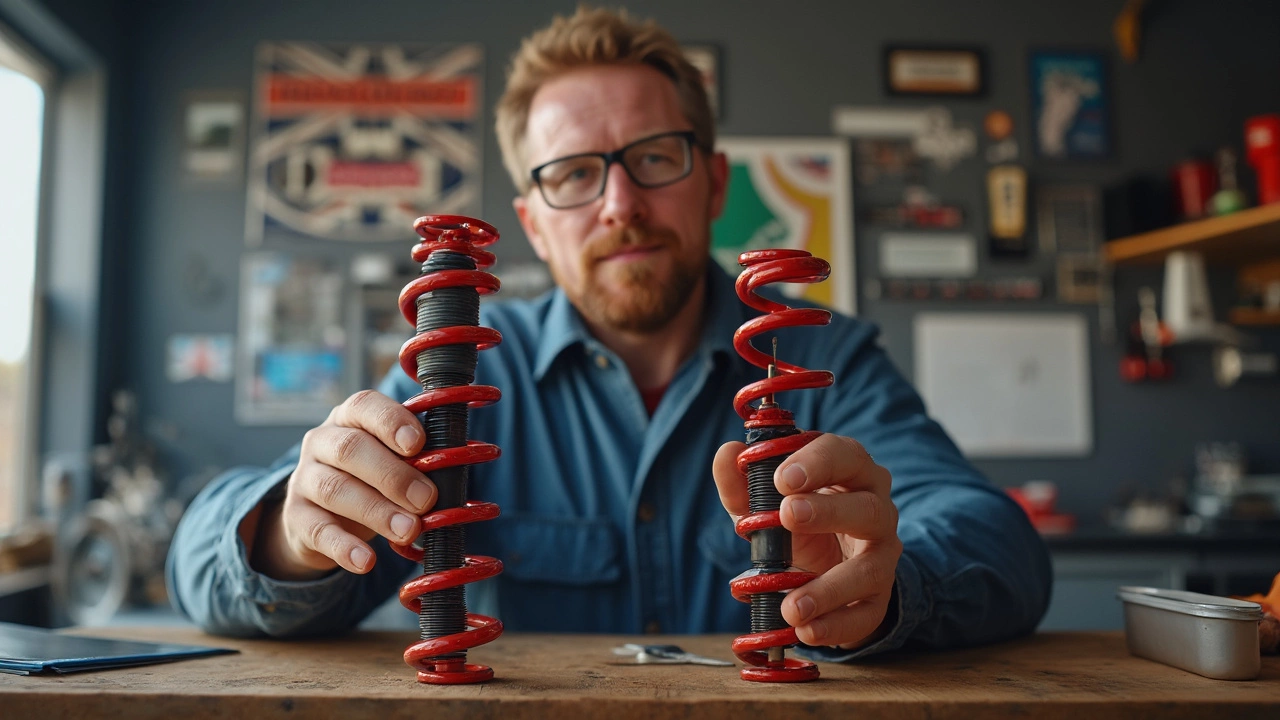Body roll is that slightly queasy tilt you feel when you whip your car into a sharp turn and the body leans over the outside wheels. It’s not just about looks—it affects your confidence when cornering and can mess with your car’s grip. You’ve probably seen cars at the track hugging tight corners with barely any lean. So what’s the deal? Can a simple part like lowering springs really make your ride behave like that?
Lowering springs are one of those mods that sound easy and promise a lot. The main idea is simple: drop the car closer to the ground, make the springs stiffer, and you should roll less. But how much difference do they actually make? More importantly, should you fork over your cash for a set if you’re chasing real handling improvements?
- What Body Roll Really Is
- How Lowering Springs Work
- Do Lowering Springs Control Body Roll?
- Pros, Cons, and Expectations
- Tips for Getting the Most Out of Lowering Springs
What Body Roll Really Is
Let’s cut through the mystery. Body roll is what happens when your car leans side to side in a turn. Picture this: you hit a corner a bit fast, and you feel the cabin shift. That’s your car’s body rolling on top of the suspension. This isn’t just an uncomfortable feeling; it can impact how much grip your tires provide and even make your steering feel less direct.
A certain amount of body roll is normal – all cars have it since the suspension is designed to soak up bumps and uneven roads. But when the body rolls too much in a turn, you get more weight pressing down on the outside tires and less on the inside ones. That means less grip, squishier response, and, sometimes, a downright sketchy feeling on the road.
Body roll isn’t just an inconvenience. On the track, too much roll can lead to slower lap times and even unpredictable handling. In regular driving, it can make the car feel less safe. Some SUVs and taller cars roll more because of their higher center of gravity and softer suspension setups, while most sports cars work hard to keep it in check.
Here’s a simple look at how body roll affects cars with different setups:
| Vehicle Type | Suspension | Typical Body Roll |
|---|---|---|
| Sports Car | Stiff | Low |
| SUV | Soft | High |
| Family Sedan | Moderate | Medium |
If you like a nimble, planted feel around corners, reducing body roll is key. That’s where upgrades like lowering springs come into play. But before jumping in, it helps to understand what’s happening under your ride so you can decide what kind of fix you actually need.
How Lowering Springs Work
Lowering springs are pretty much exactly what they sound like—replacement springs that drop your car's ride height compared to stock. They’re wound tighter or made from stronger steel, so they're usually shorter and stiffer than the factory stuff. You bolt them in place of your original springs, and instantly, the car sits lower.
That lower stance isn’t just for looks. Here’s why: When you lower your car, its center of gravity drops. That means less weight shifts to the outside wheels during turns, which can cut down on body roll. But there’s more to it than just being low.
- Stiffer springs resist compression, so as the car tries to rock side-to-side, the springs fight back more than softer stock ones would.
- Less suspension travel means there’s less room for the car to tilt before the suspension is maxed out, which tones down that old school floating feeling.
- This upgrade often pairs well with better shock absorbers—otherwise, a low and stiff car can feel jittery over bumpy roads.
| Feature | Stock Springs | Lowering Springs |
|---|---|---|
| Average Ride Height Drop | None | 1-2 inches (25-50mm) |
| Spring Rate (Stiffness) | Soft to medium | Stiff (up to 30-50% firmer) |
| Body Roll Control | Basic | Improved |
| Ride Comfort | Softer | Firmer |
The biggest thing drivers notice after putting in lowering springs is how much the car stays flatter through corners. It’s not magic, though. The stiffer setup can make rough roads feel rougher, so there’s always a tradeoff.
If you want the springs to do their best work, always get an alignment after installing them. A dropped car can throw off the angles of your wheels, messing with tire wear and grip.

Do Lowering Springs Control Body Roll?
The short answer: Yes, lowering springs do reduce body roll—but there’s more to it than just slapping on a new set and hoping for racecar vibes. Lowering springs use stiffer spring rates compared to your stock ones. Because they’re tougher to compress, your car stays flatter in corners. It’s a change you really notice the first time you push your car a bit faster through a roundabout.
Let’s get real: the lower center of gravity also helps. With the car sitting closer to the ground, there’s less leverage for the body to lean over when you’re cornering hard. That means it feels more planted, and you get less of that boat-on-waves swing. But don’t expect miracles—a daily driver with just lowering springs won't turn into a track car overnight. Still, you’ll see a definite difference in how *much* you lean compared to stock:
| Suspension Type | Average Body Roll in Degrees (45 mph Turn) |
|---|---|
| Stock Suspension | 6° |
| Lowering Springs | 3.5° |
One cool thing is that you’re likely to feel sharper steering. With less roll, the front tires stay more upright, holding the road better. That translates to better grip and more predictable handling. But here’s the catch: those stiffer springs can make rough roads more noticeable, so you’re trading off a bit of comfort for better control.
Here’s a quick look at what you actually get if you install lowering springs just for body roll:
- Reduced body lean in corners—usually by 30-50% depending on your car and the spring set
- A lower center of gravity, which means you feel more stable at speed
- Bouncier ride on bad roads, especially if your shocks aren’t upgraded
If you want to cut back body roll even more, some folks pair lowering springs with better shocks or sway bars. That’s where you really start dialing in the balance between sporty and comfortable. But even on their own, lowering springs are one of the easiest, most affordable ways to take some of the slop out of your driving experience.
Pros, Cons, and Expectations
Okay, so before you order a set of lowering springs, you’ll want the lowdown on what’s really good—and what might surprise you in the not-so-good way. This is where things get interesting, because not every change is positive and not every promise lives up to the hype.
Let’s start with the pros. You absolutely can reduce body roll with quality lowering springs. They use stiffer coils than your factory springs, so when you hit a corner, the car stays flatter. That means better grip for your tires since there’s less weight transfer. Your ride ends up feeling more responsive when changing direction. Bonus: Most cars also look better lowered, no lie.
- Better handling: Less body roll equals more stable turns and sharper steering.
- Improved appearance: Lowered stance really changes a car’s vibe—just look at any local car meet.
- Lower center of gravity: Being closer to the pavement keeps everything more planted, especially when cornering quickly.
But—and this is a big one—there are some downsides. Stiffer springs make the ride firmer, so you’ll notice more bumps and rough roads. On models without adjustable dampers, the car might feel jarring or even bouncy if the shocks can’t keep up. You also lose ground clearance, which means speed bumps and steep driveways get trickier. And if you go super low, you risk messing up your car’s suspension geometry, which can lead to excessive tire wear or alignment headaches.
- Harsher ride: Every pothole and bump feels more pronounced, especially on rough pavement.
- Less clearance: You’ll need to watch out for scraping on ramps and speed bumps.
- Suspension mismatch: Using stock shocks with lowering springs can lead to a choppy or unpredictable ride if they aren’t up to the job.
Your expectations matter a ton here. If you’re looking for track-level handling, springs alone won’t magically turn your daily driver into a race car. You’ll see improvement, but it might not match what you’ve seen online unless you pair them with good shocks, sway bars, or bushings. It’s all about balance.
"Lowering springs offer a significant improvement for street driving, but the best results come when you match them to proper dampers and align everything after installation." – Mike Kojima, engineering editor at MotoIQ
End of the day, springs are a solid first step, but managing your expectations is key. If you want great handling and daily comfort, do your research, pick a reputable brand, and consider the rest of your suspension, not just the springs.

Tips for Getting the Most Out of Lowering Springs
Trying to get the most out of your lowering springs isn’t just about swapping parts. There are a few things you can do to make sure you actually feel and see the benefits, especially if controlling body roll is your main goal.
- Start with an Alignment: When you lower your car, the wheels don’t just sit where they used to. That messes with your camber and toe settings, which can make your car feel wonky or wear your tires out fast. Always get a proper alignment after you install lowering springs. It’s not optional if you want decent handling and reliability.
- Check Your Shocks: Stock shocks aren’t always friends with aftermarket springs, especially if the new springs are stiffer or shorter. If you keep the old shocks, you could end up with a bouncy ride or weird tire contact. At the very least, make sure your shocks are in great shape—better yet, upgrade to sport or performance shocks matched to your new setup.
- Pair With Sway Bars: Lowering springs cut body roll, but installing beefier sway bars at the same time can take it even further. Sway bars connect your left and right wheels, and a stock thin sway bar just can’t handle the extra force from a lowered, stiffer setup. Want that flat, planted feel in corners? Don’t skip the sway bars.
- Watch Out for Daily Usability: It’s easy to get carried away. Slam your car too low and you’ll run into scraping, speed bump drama, or even worse—wrecked oil pans or exhaust tips. Don’t pick the lowest springs just because it “looks cool.” Practical drop heights—usually around 1 to 1.5 inches—work for most cars without turning your commute into an obstacle course.
- Don’t Forget the Tires: Grippy, performance tires matter just as much as suspension. Wider or stickier tires will give you more of the flat, direct feeling you want from lowering springs. Cupped or bald old tires erase those benefits—and then some.
If you’re curious what kind of difference you can actually expect, check this out. A famous track test (published by Grassroots Motorsports) put a stock Mazda MX-5 on lowering springs and matched shocks. Look at the changes in lap time and lateral g-force (how much stick in turns) just from springs alone:
| Setup | Lap Time (seconds) | Lateral G-Force |
|---|---|---|
| Stock suspension | 83.2 | 0.87 |
| Lowering springs + matched shocks | 81.9 | 0.92 |
A tighter lap and a stronger grip—noticeable, not just numbers on paper. So if you want the best bang for your buck: align it, pair your springs with the right shocks, consider sway bars, don’t go too low, and always run proper tires. That’s how you actually beat body roll—without just chasing looks.




